A feature article in our 2020 Fall Special, written by Edward Y. Morwick.
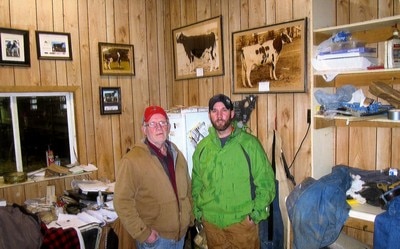
On the wall of the Glenvue farm office, larger than life, are the photographs of two cows. In the first picture is Glenvue Nettie Jemima (EX-13*), bred by Douglas S. Dunton, the grandfather of the present Glenvue owner. “Nettie” was owned by Dr. Hector I. Astengo of Rosafe Farms when, at twelve years of age, she was voted All-Canadian aged cow in 1954. The other cow is A.B.C. Inka May, pictured as the All-Canadian 4-year-old of 1947. Bred at Glenvue, she was carried in dam to the Armstrong Bros.’ farm and was registered under their prefix as was permitted by the rules at that time. Under today’s rules, her prefix would have been Glenvue. A.B.C. Inka May was part of the transaction when the Armstrongs sold their A.B.C. herd to Astengo in 1948.
Apart from both being bred by Douglas S. Dunton, these cows had this in common: both were sired by James Henderson-bred bulls. In Nettie’s case it was Strathaven Top Grade, a son of Inka Supreme Lillian (EX), she by Spring Farm Inka Jewel and out of a Hays Supreme dam. May’s sire was Inka Supreme Reflection, a son of Spring Farm Inka Jewel out of another Hays Supreme daughter and was, therefore, Lillian’s three-quarter brother.
Here were two of the animals who shaped the bloodlines that made the Canadian Holstein the world’s most popular dairy cow. In the words of Hugh Colson, the Holstein Journal editor who reported the sale results of Henderson’s Strathaven herd after its dispersal in 1964:
 “There were many bidders anxious to share the bloodlines that started today’s most popular families. Past-President D.S. Dunton opened the sale, pointing out that Inka Supreme Reflection came from the Henderson herd to sire the dam of A.B.C. Reflection Sovereign and Strathaven Top Grade came from the same place to sire Glenvue Nettie Jemima, dam of famous sons when mated to ‘A.B.C.’.”
“There were many bidders anxious to share the bloodlines that started today’s most popular families. Past-President D.S. Dunton opened the sale, pointing out that Inka Supreme Reflection came from the Henderson herd to sire the dam of A.B.C. Reflection Sovereign and Strathaven Top Grade came from the same place to sire Glenvue Nettie Jemima, dam of famous sons when mated to ‘A.B.C.’.”
Those A.B.C. sons of Nettie were Rosafe Magician, Signet, Magic and Citation R. Another son of considerable influence was Rosafe Centurion (EX-Extra), Nettie’s son by Inka Supreme Reflection.
And there they were on an office wall. Glenvue Nettie Jemima and A.B.C. Inka May. I had to sit down.
The Duntons’ Glenvue herd has always been famous wherever good Holsteins are bred. This was the first herd to win a Master Breeder’s shield three times. The first shield was presented to Doug Dunton in 1953. Ralph and Earl Dunton joined their father as partners shortly thereafter, and in 1964 a second shield was awarded to D.S. Dunton & Sons. In 1966, because of Brampton’s encroaching subdivisions, the Glenvue herd was dispersed. Ralph and his son Jim retained the Glenvue prefix and relocated to Inglewood, Ontario where the centerpieces of a new foundation were two Thornlea Texal Supreme daughters, Tara Emerald and Edora Texal Ruth. Under Ralph and Jim’s ownership the Glenvue herd won its third Master Breeder’s shield in 1987. And, judging from the cows on display that day, it won’t be long before the fourth shield comes along, so that Glenvue will be the only herd in history to win a Master Breeder’s shield four times.
In the 2020 sale catalogue, animals whose stable names started with “E” were descended from “Emerald”, those whose names began with an “R” traced back to “Ruth”.
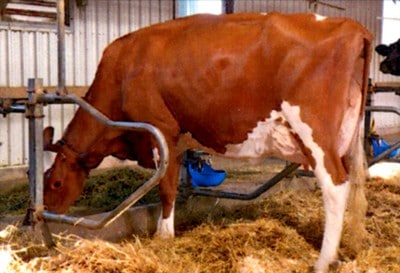
A foundation animal added later was Lexis Dundee Lulu, bought as a calf, who went on to classify Excellent five times and to earn five star brood cow points. Lulu’s granddam was the far-famed Ravenswell Lydia (EX-92-19*). Lulu, herself, was the granddam of two of the herd’s top animals, Glenvue Doorman Liz and Glenvue Doorman Lacey. These cows were 100% the same blood, being out of two of Lulu’s Goldwyn daughters. “Lulu turned out to be a winning proposition,” says Jim. “She was easy to get in calf and she always had heifers. That’s the way you end up with a good cow family.”
The Online Auction
The traditional way of selling dairy cattle is to take the animals to a sales arena where they are auctioned off in a public setting. But not so today. Because of the Covid-19 virus, Jim and Geoff Dunton’s Glenvue herd, in a sale that was managed by Walker Dairy Sales, was sold online on October 23, 2020.
These online sales, according to many, are not what they’re cracked up to be. At the very least, they’re going to take a lot of getting used to. “Let’s stick with the live auctions,” is a remark we often hear.
They sell these cows at the same time. The prevailing bid appears on a computer screen. Let’s say you’re interested in six cows. You’re concentrating on one of these cows while at the same time the sales of the other five are ready to close. So you jump back and forth. In the result you might miss all six head.
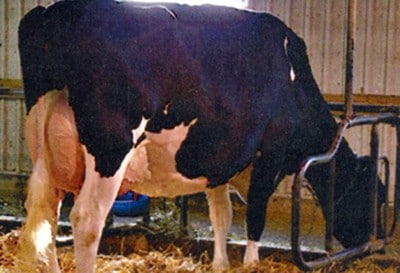
Ross Miller, a friend of mine from the Dunlea days (we both worked for Dick Schleissner in the 1960’s), earns his living on his cash crop farm near St. Thomas. Recently, Ross developed a hankering to own a Holstein cow or two. Just for old times’ sake, you understand. He suggested we go partners.
At the Open House the day before the sale, hands sanitized and our faces masked, we took a look at the Glenvue line-up. What a herd! “If there was a Royal Winter Fair this year,” I said to Ross, “they would have the winning Dairy Herd.” Two rows of twenty cows each, a long line of lustrous beauties that included Liz and Lacey, both recently classified Excellent and hot to trot.
Then our eyes were drawn to a pair of red and white full sisters, Glenvue Awesome Elly Jody, two years of age, and her 3-year-old full sister, Glenvue Awesome Elly Joan. These heifers were built just the way you like them, hard tops, picture-book udders and correct feet and legs.
“There,” said I, smacking my lips, “is the pair we will want to bid on.” Problem was the 3-year-old had a high somatic cell count, apparently due to an infected rear quarter. “Maybe we can leave her here until they get it cleared up,” said Ross.
On sale day Ross sat down with Glenn Sims of Glenbert Holsteins, Woodstock, ON at the computer. He found it difficult, practically impossible, to watch half a dozen cows at the same time. In spite of that, he was next to last bidder on five head. When the red full sisters went past $4,000.00, he dropped out. He went home empty-handed.
The milking females made an average of $3,132.00. The median price on the bred and open heifers was $2,373.00 and $1,854.00, respectively. Total receipts amounted to $260,760.00 for an overall average of $2,460.00 on 106 head. Glenvue Doorman Liz topped the sale, selling to Rick Fieldhouse at $7,500.00. “Lacey”, her full sister, sold for $6,700.00, the bid of Don Reid.
A focus on type, bred, not bought
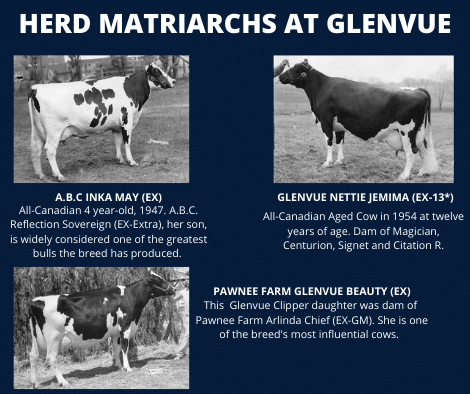 The Duntons’ focus, from the time Doug bought his first Holstein in 1929 to the day of the final sell-out in 2020, has always been on breeding, not buying, attractive animals, then getting them out to the shows. Competing on a national basis, they have had few equals – Jack Fraser’s Spring Farm and Charlie Cerswell’s Bond Haven are two of the herds that come to mind. But for consistent results over a ninety-year period, the Duntons have had few serious competitors.
The Duntons’ focus, from the time Doug bought his first Holstein in 1929 to the day of the final sell-out in 2020, has always been on breeding, not buying, attractive animals, then getting them out to the shows. Competing on a national basis, they have had few equals – Jack Fraser’s Spring Farm and Charlie Cerswell’s Bond Haven are two of the herds that come to mind. But for consistent results over a ninety-year period, the Duntons have had few serious competitors.
Nothing has pleased them more than to campaign a string of show cows at the C.N.E. and the Royal Winter Fair where, more often than not, they cleaned house.
“We liked to breed and we liked to show,” says Jim Dunton, now sixty-five years of age. “But these things, it seems, belong to the past. Today there is little demand for our kind of cattle. Show cows are down in price and bull sales? Forget about it. Ours was never a high index herd and on top of that, the studs are starting to breed their own bulls.”
Back in the 1950’s, two bulls proven at Duntons’, A.B.C. Midnight Joe (EX-Extra) and Rosafe Prefect (EX-ST), were sold to A.I. studs. But there weren’t many males who carried the Glenvue prefix who went into A.I. service. But where other farmer-breeder herds were concerned, the Glenvue product went out the door fast. Of that long list of herd-helpers, far and away the most influential was Glenvue Clipper, the Prefect son from an Elmcroft Voyageur M. dam who Lester Fishler took to his Pawnee Farm in Nebraska.
Glenvue Clipper sired Pawnee Farm Glenvue Beauty (EX), the dam of the breed-changing milk bull, Pawnee Farm Arlinda Chief. The Chief stood at the top of the U.S. Red Book’s “genes in common” list all through the 1980’s, ahead of Round Oak Rag Apple Elevation. In other words, in the 1980’s the Chief blood flowed through the veins of North American Holsteins more than that of any other sire. And 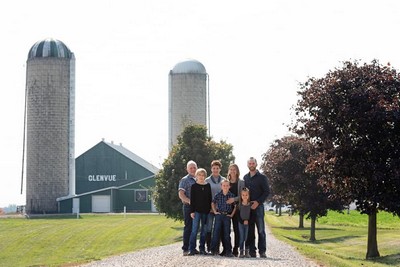 speaking of Elevation, there’s Glenvue breeding on the bottom side of his pedigree. Round Oak Nettie Emaline, his granddam, was sired by a son of Rosafe Centurion, he the son of Glenvue Nettie Jemima (EX-13*).
speaking of Elevation, there’s Glenvue breeding on the bottom side of his pedigree. Round Oak Nettie Emaline, his granddam, was sired by a son of Rosafe Centurion, he the son of Glenvue Nettie Jemima (EX-13*).
Aftermath
“We took one cow out of the sale,” said Jim Dunton, “a ten-year-old named Glenvue FC Vera. This was after her daughter brought $6,800.00. The old girl wouldn’t have brought more than $1,500.00 so we decided to keep her. If she hadn’t had that nice daughter we wouldn’t have bothered. We’ll probably flush her.”
The Glenvue Dispersal. Was it the end of something? Was it Duntons’ goodbye to the Holstein cow?
Stay tuned.
